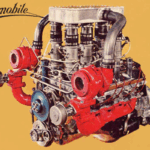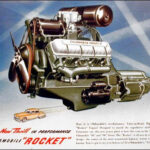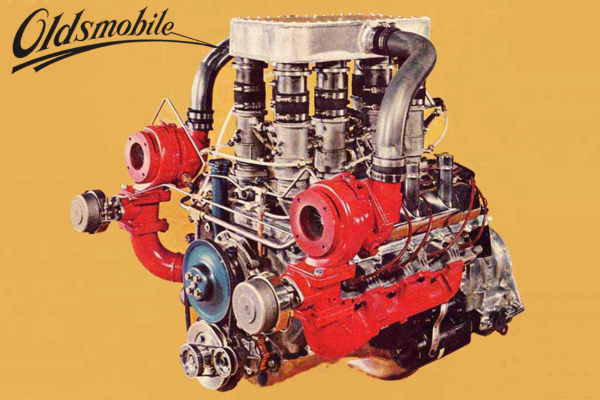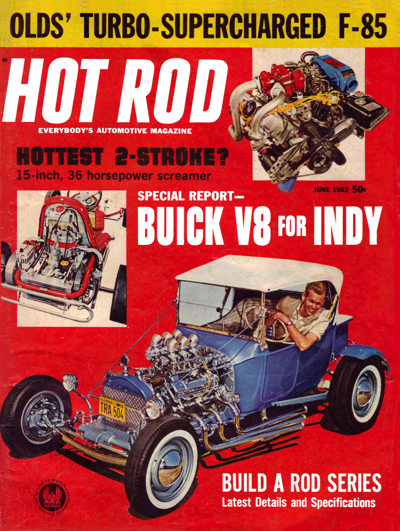221-255-260-289-302-and 351 Windsor Engines
Ford’s Small Block V-8 was first introduced in 1962 for use in the new Ford Fairlane and Mercury Meteor intermediates. It was a departure from previous Ford engines in that it was small — only 20″ wide across the exhaust manifolds, excluding flanges. For comparison, the small-block Chevy at that time measured 27″ across. The small-block Ford was also light; as the complete engine, including all accessories, bell housing, and clutch, weighed less than 475 pounds. The 239 cu. in “Y-block” V8 introduced in 1954 weighed 200 pounds more.
The small-block Ford engine was released in two displacements in its first year. The smallest, at 221 cubic inches, had a bore and stroke of 3.50″ x 2.87″. With an 8.7:1 compression ratio, power output was 143 HP at 4,500 rpm and 217 ft-lbs of torque at 2,200 rpm. The 260-cid version, released later in the 1962 model year, had a bore and stroke of 3.80″ x 2.87″. With the same compression ratio, power output was 164 hp and 258 ft-lbs of torque. This engine was perfect for use in smaller Ford cars, such as the Falcon, Fairlane, Comet and Meteor.

Cross Section of the famous 289 “Hi-Po” 271 HP V8
To save weight, Ford used “thin-wall” casting techniques, which first been seen on the 1960 Falcon six-cylinder engine. This enabled the engineers to design an engine in which casting wall thickness could be tightly controlled, eliminating excessively thick/heavy sections of the engine. All OHV Ford V-8 engines up to this time had been of the Y-block design, but to save weight, this new small-block eliminated the “Y-block” skirts below the centerline of the crankshaft. Not having this lowered skirt area did not sacrifice anything in the way of bottom-end strength, even with the stock two-bolt main-bearing caps. In fact, all engines in the Small Block family had two-bolt main-bearing caps including Shelby and Ford Hi-Po 289s. The only exception was the Tunnel Port 302, which used four-bolt-main caps.
The small-block was over-square, meaning that the bore was larger than the stroke and used a cast nodular crankshaft, which weighed only 37 pounds. The connecting rods were forged-steel, and the pistons were conventional cast aluminum. The small-block also used a hydraulic-lifter camshaft as standard, and in another departure from previous Ford engines, the Ford Small Block used individually mounted cast-iron rocker arms, similar to the design used on the Chevrolet small-block V-8s. These were cheaper, lighter, and simpler to manufacture than the previous shaft-mounted rockers. Rocker ratio was 1.6:1.
Otherwise, the cylinder heads were a typical wedge design with valves measuring 1.59″ on the intake and 1.39″ on the exhaust for the 221 and 1.67″ intake and 1.45″ exhaust on the 260. Initially, the 221 and 260 engines used a cast-iron two-barrel intake manifold and carburetor. A 4-barrel intake and mechanical lifter Hi-Po 260 was produced but only available over the counter. I was fitted to early Shelby Cobras, however.
The small-block was enlarged in 1964 by increasing the bore to 4.00 inches it now displaced 289 cubic inches. In this form, the 289 was an available power plant practically every Ford vehicle from 1964-1967.
There were two major changes made to the small-block during its life. In mid-1965, Ford switched to a six-bolt bell housing from the previous five-bolt unit. The six-bolt bell housing was designed to accept a larger 11-inch clutch and the Ford “top-loader” manual transmission. Engines built after February 1966 got different rocker arms. Previously, all small-blocks used conventional slotted rockers with a ball-and-stud pivot. These were replaced with “rail” rockers on all subsequent engines, except the 289-cid engine and Boss 302. The rail rockers have a tab on either side of the rocker tip that fits over the valve stem and thus keeps it aligned.
The next change occurred in 1968. By increasing the 289’s bore to 3.00″, the engine displaced 302 cubic inches. This was the practical displacement limit for the engine, given its dimensions. By the 1980s the small-block 302 became the “big” engine in most Ford vehicles, and it was the engine that powered the 5.0 Mustangs.
In 1969, Ford raised the deck height by 1.275″. This made it possible to install a crankshaft that had a 0.50″ greater stroke, resulting in 351 cubic inches. The engine became known as the 351 Windsor (351W), because it was made at Ford’s Windsor engine plant. Thereafter, all 221-351 engines with the conventional wedge head became known as “Windsor” Small Blocks











